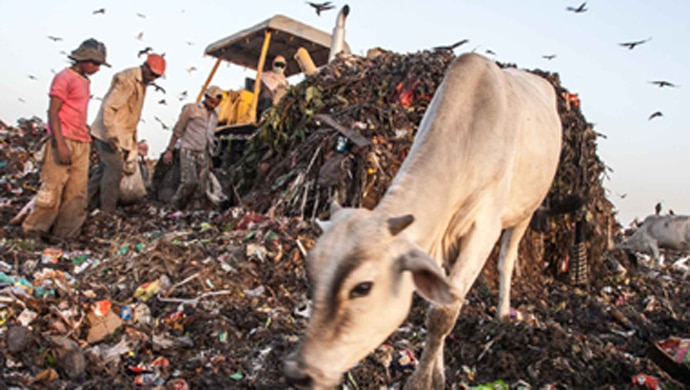Ghazipur landfill collapse: What Delhi can do to prevent another tragedy like this

On September 1, a large portion of the oldest landfill in Delhi, the Ghazipur landfill collapsed killing two people and washing away four vehicles. The 50-metre high (taller than a 15-storey building) landfill possibly collapsed because of the sheer weight of close to five million tonnes of garbage being piled on this 27-acre site since 1984.
By 2002, that is, 15 years ago, it was well past its saturation height of 20 metre and for all purposes should have been shut down by what is now the East Delhi Municipal Corporation. This clearly did not happen and the waste continues to be dumped here wrongly till now.
The landfill today receives mixed unsegregated waste from New Delhi and East Delhi which is a clear violation of the Solid Waste Management Rules of 2016 which in Section 15(q) and (t) clearly mandates “on site processing of waste” rather than sending it to centralised processing plants, thus promoting "decentralised processing of waste at community level". Section 15 (zi) also mandates the allowance of “only the non-usable, non-recyclable, non-biodegradable, non-combustible and non-reactive inert waste and pre-processing rejects and residues from waste processing facilities to go to sanitary landfill… However, every effort shall be made to recycle or reuse the rejects to achieve the desired objective of zero waste going to landfill".

This would mean that 50 per cent-60 per cent wet waste that is generated is composted locally, 20 per cent-25 per cent dry waste like paper, plastic, glass etc., is sent for recycling and only 15 per cent-20 per cent residual waste is sent to landfills. If this had been implemented, the Ghazipur landfill collapse of September 1, could have been avoided as it would not have been overfilled to capacity.
What happened on that fateful day at Ghazipur can happen at Bhalaswa, Okhla and in any of the hundreds of dumpsites anywhere in India. These are tragedies waiting to happen.
So, till date what have we done other than engaging in a merry and completely unproductive blame game between the municipality under whose jurisdiction the area falls and watch a helpless and angry National Green Tribunal who routinely raps everybody on the knuckles for non-compliance of rules?
What can we do besides the ridiculous exploration of fresh sites to dump our ever-increasing loads of waste on hapless farmers and low income groups who live in hinterlands?
There must be a solution to our breathing polluted air, drinking contaminated water, falling prey to myriad respiratory illness and having our cities and people drowning in waste.
The solution is to stop depending on landfills to the extent we do, something also underscored in our Solid Waste Management Rules, 2016.
Successes in other cities like Mysuru (Karnataka), Coimbatore (Tamil Nadu), Thane , Pune and Vengurla (Maharashtra) and many others across India tells us that Delhi’s waste management should be broken down into smaller sections, ward-wise (containing a cluster of RWAs) or other in units, where waste is segregated within a kilometre of its generation.
Solutions we could implement could be a strict incentive/penalty-based implementation of segregating waste at household and ward level so that no waste leaves the source of generation. This is the decentralised model of waste generation. All wet waste like food waste could be composted and dry waste like paper, plastic, glass could be sold off to local kabadiwallahs for recycling thus saving valuable resources, and saving these a certain route to the landfill.
Let us manage waste at decentralised level by providing space for waste-pickers/kabadis to work. "Dhalaos" should be identified for such purposes and converted to processing centres.

Manufacturers should be held responsible for non-recyclable waste, including non-recyclable plastic by better implementation of the Extended Producer Responsibility (EPR) mandated in the SWM Rules, 2016, and Plastic Waste Management Rules, 2016.
This will ensure all Kurkure and chips packets and all single-use shampoo sachets, tobacco packets etc., are taken back by manufacturers. This will also be applicable to sanitary and electronic waste. Can you imagine what a lot of waste will then get diverted from landfills? At least 10 per cent-15 per cent.
As Manjula, a 40-year-old waste-picker woman at Ghazipur told me, “Our livelihoods depend on the waste the city generates. We clean the city by picking through the trash that people throw away.”
If not for the Manjulas of the city, Delhi would have many, many more landfills waiting to collapse and drown us in waste. What happens to Manjula if no dry waste comes to landfills?
We have a huge army of waste-pickers, itinerant buyers and scrap dealers who form 1 per cent of the urban population in India. This is the silent almost invisible sector which sorts out tonnes and tonnes of city’s waste and recycles it so that at least 20 per cent of it is diverted from landfills. It also earns them a living.
We owe it to them to create a sustainable waste model which is inclusive of this urban poor.
This will include equipping them with safety gear, upgrading their businesses, providing them with health and security benefits, making sure their children go to schools and not to the local dhalao to pick waste.

